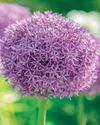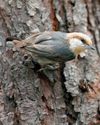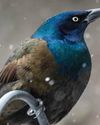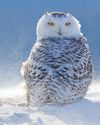
FLYCATCHING has a particular meaning in the world of birds: perching in one spot to watch for flying insects, swooping out to catch them in midair and then returning to the perch. And members of the flycatcher family are masters of this behavior.
More than 400 species of flycatchers are found between Alaska and the southern tip of South America, most of them living deep in the tropics. North of the Mexican border, about 35 species are seen regularly.
Bird-watchers sometimes have trouble identifying flycatchers because so many kinds look almost identical and are recognized mainly by their voices. When getting to know these birds, it helps to start by separating them into categories. Here's a brief introduction to the main groups of flycatchers.
The Bold Kingbirds
These flycatchers are famed for their commanding behavior, fearlessly attacking much larger birds that get too close to their nests-crows, hawks and even eagles.
The eastern kingbird is widespread in summer over the eastern two-thirds of North America, often perching on fences or roadside wires. You may notice it first by its buzzy, sputtering cries as it flies overhead, chasing away some big bird and flashing the broad white band at the tip of its tail. During summer in the Great Plains, the eastern kingbird overlaps with the western kingbird, which has similar habits but different colors, including a bright yellow belly.
Five other kingbirds are found in Florida, parts of the West and near the Mexican border. And a relative of kingbirds, the spectacular scissortailed flycatcher, is seen from Texas up to Nebraska, east to Missouri and south to Louisiana. In addition, it represents Oklahoma as the state bird.
The Gentle Phoebes
Esta historia es de la edición August/September 2023 de Birds & Blooms.
Comience su prueba gratuita de Magzter GOLD de 7 días para acceder a miles de historias premium seleccionadas y a más de 9,000 revistas y periódicos.
Ya eres suscriptor ? Conectar
Esta historia es de la edición August/September 2023 de Birds & Blooms.
Comience su prueba gratuita de Magzter GOLD de 7 días para acceder a miles de historias premium seleccionadas y a más de 9,000 revistas y periódicos.
Ya eres suscriptor? Conectar

Basics of Hydroponics
Use these top tips and plant picks to have a successful soil-free garden

Rooted in Resilience
These hardy perennials will thrive in most zones

Social and Supportive
Brown-headed nuthatches take a helpful approach to raising their young

All About Owl Pellets
And why you should give a hoot about them

Ask the Experts
Advice from our pros about houseplants, bird feeding and more

BRING THE OUTDOORS IN
Making a terrarium is about as close as you can get to a Zen DIY project. Once you have gathered the proper materials and squared away your plant selections, it's as simple as layering it all together and watching your mini ecosystem thrive. Here, I'll walk you through my foolproof process and cover all the required elements for good filtration, healthy soil, strong root growth and resistance against fungus and disease.

GROW THIS. NOT THAT
Six easy-to-grow houseplants—and six that may not be the right choice for you

Winter MAGIC
Forecasts may be frigid, but grab your binoculars because birding opportunities are still incredible

Sense or Nonsense? - Why some birds can taste and smell - but others can't
Does a porcelain berry taste like a blueberry to a gray catbird? Does a block of lard smell like frying bacon to a northern flicker? The short answer is no. While some avian species do have a well-adapted sense of taste or smell, they can't distinguish between flavors and odors the way humans can. They're not picking up every ingredient in the suet you put out, says José Ramírez-Garofalo, an ornithology researcher at Rutgers University in New Jersey and the director of Freshkills Biological Station in Staten Island, New York.

Maple Mania - Amazing facts about this fall foliage mainstay
Amazing facts about this fall foliage mainstay